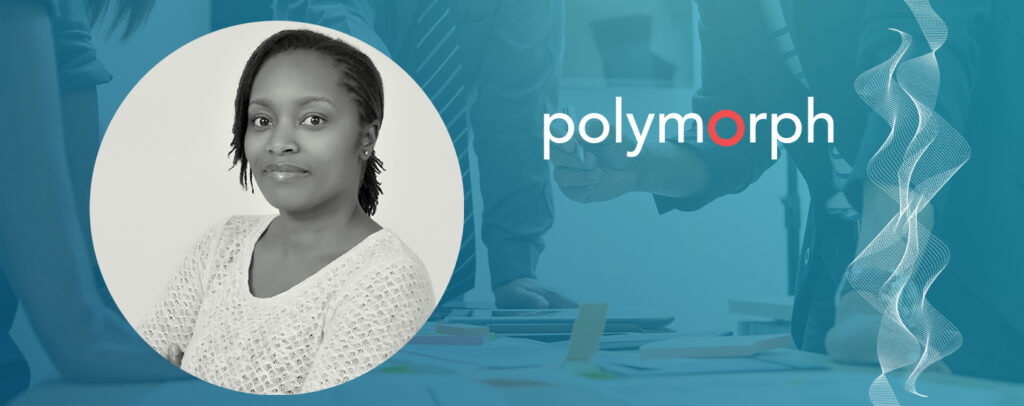We recently interviewed Margaret Wanjiru who shared her experience working as a senior product manager at Polymorph while living in Kenya. Here is a view of her day-to-day routine at Polymorph including some thoughts on the company’s culture, inclusivity, digital communications and remote work. For anyone working remotely or managing remote teams, this article should be insightful.
How long have you been working for Polymorph?
I joined Polymorph in late November 2021 as a senior product manager and have been working as a product manager for about 12 years.
When did you first start working as a product manager?
I first started working as a product manager a year after completing my computer technology studies in 2010. My career journey started with my previous CEO noticing that I have a very business-oriented mind and exceptional people skills. Since the company I was with at the time was establishing a new product development department, he suggested that I join this department as a product development implementer. This opportunity laid the foundation of my product management career. It is here that I got introduced to lean startup principles, product design, user research and testing. I went on to work there for about 5 years, leading product development for existing B2C products as well as the discovery and testing of new B2C products.
What would you say is the main difference working for Polymorph compared to your past experience working as a product manager?
The very first thing that comes to mind is the Polymorph culture and Polymorph’s absolute commitment to putting people over process. Humans come first, which includes the employees and their families, our clients and the people who end up using the products that we build.
I have never experienced a more remarkable company culture than that of Polymorph. Not only are management and colleagues super supportive, they are also absolutely focused on making sure that everyone is engaged and that the company morale is high.
The second is how Polymorph cares about delivering value for clients as opposed to just building software. During the product development process all stakeholders – including developers, UX designers, UX researchers, and the clients – are involved in all stages. We directly interact with our customer teams and their users to get first-hand feedback. We build the product together and we make the decisions together as a team; it’s a collaborative team effort as opposed to individual tasks completed in isolation and “checked” upon completion.
The project teams at Polymorph are assembled properly. I have not seen teams that work this well together with shared levels of customer obsession. Each project includes the following specialists: a UX team, a product manager, QA, a dev team and a technical architect.
In my previous roles, the product manager’s role was more of a generalist one where I would wear various hats such as UX researcher, QA and UX designer at some point during the project. At Polymorph it’s all about inclusivity and collaboration; there is no I in the team – it might be a cliché, but it is how I experience working at Polymorph.
Working remotely in a different country, how do you get to feel like you are part of a team?
A common misconception of remote work is that it leads to a loss of productivity and diminished supervision. However, with constant feedback loops, virtual meetups, and Polymorph’s commitment to ensure that all employees have what they need to continue working as if at the office, working remotely and doing so from a different country makes no difference – I always feel like part of the Polymorph team. We have a detailed and clear remote work strategy and digital communication plan that include, for example, various Slack channels. We use Slack for team building, where we collaboratively play daily games such as Wordle, and we likewise use it for team communication, video conferences, and client communication. There’s even a channel for sharing humorous content. All of these efforts show that Polymorph cares about me as an employee and it ensures consistency, productivity, and a sense of stability and belonging.
What does a typical work day or week look like at Polymorph?
We typically start our day by discussing our priorities, the impediments and brainstorming how to resolve these. We use daily stand-ups to ensure everything is running smoothly and agile methodologies such as Scrum (for team structure and schedules) and Kanban (to help visualise tasks). Every two weeks at the end of a sprint, we have project reviews where the team demos the project progress to all stakeholders including the client team. We also hold retrospectives where we look at how the two weeks played out and how the sprints can be improved. We are entirely transparent, and the client team, especially the product owners, are included every step of the way. We also use the various dedicated Slack channels I’ve mentioned to ensure real-time and speedy collaboration between internal teams and client teams.
Any last remarks?
I’m going to explain this at the hand of a recent experience I had. I was feeling a bit sick yet not to the extent that I felt I needed a day off. Instead of accepting that I’ll be able to work albeit not feeling 100%, Lize (our CEO) and the team insisted that I take a sick day, rest and recover, and the team was more than happy to stand in for me. This was a time when we were preparing for the first release of one of the projects that I’m working on, which had a tight deadline and delivery pressure. This, to me, is a true reflection of Polymorph’s people before profit approach.





